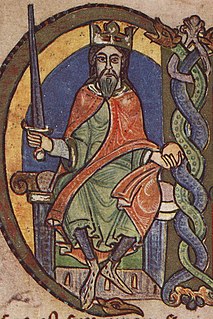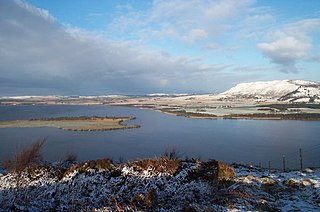
Style of the monarchs of Scotland is about the styles and forms of address used by Scottish royalty, specifically the monarchs of Scotland from the earliest times until the present, including monarchs from the Pictish period to the British period.

Style of the monarchs of Scotland is about the styles and forms of address used by Scottish royalty, specifically the monarchs of Scotland from the earliest times until the present, including monarchs from the Pictish period to the British period.
Examples of the earliest styles are primarily found in sources originating from Ireland. For the earlier medieval period, Annals of Ulster (AU) and Annals of Tigernach (AT) derive from the Iona Chronicle , a chronicle kept in Scotland. The Annals of Innisfallen are not as reliable, and the forms given in that source, when in doubt, do not need to be trusted. Other sources used here are the Annals of Connacht (AC) and the Chronicon Scotorum (CS) The style almost always King's name, followed by patronymic, followed by title. The source of each style is given in brackets, followed by the year under which it follows (s.a. = sub anno); it is usually the year in which the king died. Until the eleventh century, there is no one fixed term for Scotland in Gaelic. Before tenth century, the kings the area now comprising modern Scotland are either "of Picts", "of Fortriu" or "of Alba", standardising after 900; but the rulers of Moray, not by historiographical tradition called "King", are called king in the sources; moreover, they are sometimes called "kings of Alba".
The Poppleton manuscript preserves a grant supposedly made by King Nechtan to the monastery of St. Brigid at Abernethy, c. early sixth century:
In the Scottish period, the charter styles vary at first, but later become more formulaic. Here are some examples from the early charter period. The Roman numeral which follows is the number given to the charter in Archibald C. Lawrie's Early Scottish Charters: Prior to A.D. 1153, (Glasgow, 1905):
From David I onwards, the royal style is either "rex Scottorum" or "rex Scotiae".
In the late Middle Ages the styles "rex Scottorum" ("king of the Scots") and "rex Scotiae" ("king of Scotland") were used interchangeably. Similarly, the Monarchs of England could be referred to as the "king of the English" as indeed Edward II of England was in the Declaration of Arbroath (1320). King of the Scots was used in "The Declaration of the Clergy in favour of Robert the Bruce" (1334), as it was in the charter by which Edward Balliol ceded the southern counties of Scotland to England. However, in many other documents King of Scotland was the preferred style, including "The Letter of the Magnates of Scotland to the King of France" (1308), "The Settlement of Succession on Robert the Bruce" (1315), the Treaty of Corbeuil (1326), the Treaty of Edinburgh–Northampton (1328), the Papal Bull authorising the anointing of Scottish Kings (1329) and the Treaty of Berwick (1357). This remained the case until the last three monarchs of Scotland, William II, Mary II and Anne, who became Queen of Great Britain following the Acts of Union 1707.
| | This section needs expansion. You can help by adding to it.(June 2008) |
Scottish monarchs were addressed as "Your Grace", before the Acts of Union of 1707, when Scotland became part of the Kingdom of Great Britain. From then on, British monarchs were addressed as "Your Majesty".
Causantín or Constantín mac Cináeda was a king of the Picts. He is often known as Constantine I in reference to his place in modern lists of kings of Scots, but contemporary sources described Causantín only as a Pictish king. A son of Cináed mac Ailpín, he succeeded his uncle Domnall mac Ailpín as Pictish king following the latter's death on 13 April 862. It is likely that Causantín's reign witnessed increased activity by Vikings, based in Ireland, Northumbria and northern Britain. He died fighting one such invasion.

Strathclyde, originally Cumbric: Ystrad Clud or Alclud, was one of the early medieval kingdoms of the Britons in what the Welsh call Hen Ogledd, the Brythonic-speaking parts of what is now southern Scotland and northern England. The kingdom developed during the post-Roman period. It is also known as Alt Clut, a Brittonic term for Dumbarton Castle, the medieval capital of the region. It may have had its origins with the Brythonic Damnonii people of Ptolemy's Geography.

David I or Dauíd mac Maíl Choluim was a 12th-century ruler who was Prince of the Cumbrians from 1113 to 1124 and later King of Scotland from 1124 to 1153. The youngest son of Malcolm III and Margaret of Wessex, David spent most of his childhood in Scotland, but was exiled to England temporarily in 1093. Perhaps after 1100, he became a dependent at the court of King Henry I. There he was influenced by the Anglo-French culture of the court.
Alpín mac Echdach was a supposed king of Dál Riata, an ancient kingdom that included parts of Ireland and Scotland.
Óengus mac Fergusa was king of the Picts from 820 until 834. In Scottish historiography, he is associated with the veneration of Saint Andrew, the patron saint of Scotland.
Fergus Mór mac Eirc was a legendary king of Dál Riata. He was the son of Erc of Dalriada.
Loarn mac Eirc was a legendary king of Dál Riata who may have lived in the 5th century. He was buried on Iona.
Suibne mac Cináeda was an eleventh-century ruler of the Gall Gaidheil, a population of mixed Scandinavian and Gaelic ethnicity. There is little known of Suibne as he is only attested in three sources that record the year of his death. He seems to have ruled in a region where Gall Gaidheil are known to have dwelt: either the Hebrides, the Firth of Clyde region, or somewhere along the south-western coast of Scotland from the Firth of Clyde southwards into Galloway.
Findláech of Moray was the King or Mormaer of Moray, ruling from some point before 1014 until his death in 1020.
Máel Coluim of Moray was King or Mormaer of Moray (1020–1029), and, as his name suggests, the son of a Máel Brigte. As with his predecessor Findláech mac Ruaidrí, sources call him "King of Scotland."
The so-called House of Moray is a historiographical and genealogical construct to illustrate the succession of rulers whose base was at the region of Moray and who ruled sometimes a larger kingdom. It is much the same as Cenél Loairn, an originally Gaelic concept to express one of the two rivalling leader clans of early medieval Scotland.
Uuen (Wen) or Eogán in Gaelic was king of the Picts between 837–839.

King Bridei III (616/628?–693) was king of the Picts from 672 until 693.

The origins of the Kingdom of Alba pertain to the origins of the Kingdom of Alba, or the Gaelic Kingdom of Scotland, either as a mythological event or a historical process, during the Early Middle Ages.
Rí, or commonly ríg (genitive), is an ancient Gaelic word meaning "king". It is used in historical texts referring to the Irish and Scottish kings, and those of similar rank. While the Modern Irish word is exactly the same, in modern Scottish Gaelic it is rìgh, apparently derived from the genitive. Cognates include Gaulish Rix, Latin rex/regis, Spanish rey, French roi, Sanskrit raja, and German Reich.
Óengus mac Fergusa may refer to:

St Serf's Inch or St Serf's Island is an island in Loch Leven, in south-eastern Perth and Kinross, Scotland. It was the home of a Culdee and then an Augustinian monastic community, St Serf's Inch Priory.

Political and military events in Scotland during the reign of David I are the events which took place in Scotland during David I of Scotland's reign as King of Scots, from 1124 to 1153. When his brother Alexander I of Scotland died in 1124, David chose, with the backing of Henry I of England, to take the Kingdom of Alba for himself. David was forced to engage in warfare against his rival and nephew, Máel Coluim mac Alaxandair. Subduing the latter took David ten years, and involved the destruction of Óengus, mormaer of Moray. David's victory allowed him to expand his control over more distant regions theoretically part of the Kingdom. In this he was largely successful, although he failed to bring the Earldom of Orkney into his kingdom.